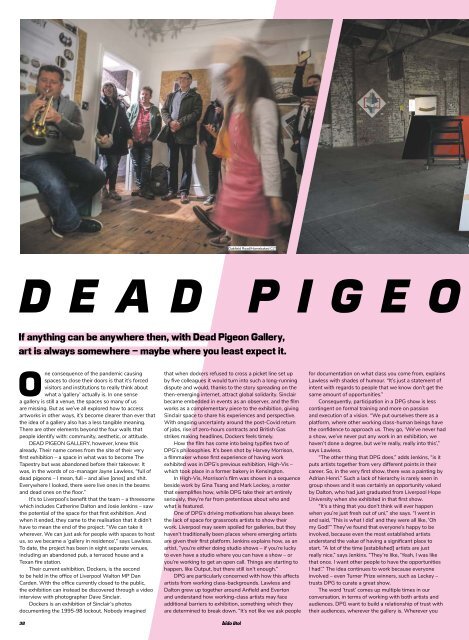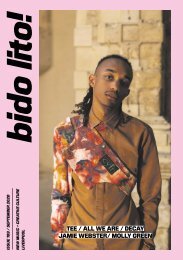Issue 113 / April-May 2021
April-May 2021 issue of Bido Lito! magazine. Featuring: PIXEY, AYSTAR, SARA WOLFF, DIALECT, AMBER JAY, JANE WEAVER, TATE COLLECTIVE, DEAD PIGEON GALLERY, DAVID ZINK YI, SAM BATLEY, FURRY HUG, FELIX MUFTI-WRIGHT, STEALING SHEEP and much more.
April-May 2021 issue of Bido Lito! magazine. Featuring: PIXEY, AYSTAR, SARA WOLFF, DIALECT, AMBER JAY, JANE WEAVER, TATE COLLECTIVE, DEAD PIGEON GALLERY, DAVID ZINK YI, SAM BATLEY, FURRY HUG, FELIX MUFTI-WRIGHT, STEALING SHEEP and much more.
You also want an ePaper? Increase the reach of your titles
YUMPU automatically turns print PDFs into web optimized ePapers that Google loves.
Oakfield Road/Homebaked CLT<br />
DEAD PIGEO<br />
If anything can be anywhere then, with Dead Pigeon Gallery,<br />
art is always somewhere – maybe where you least expect it.<br />
One consequence of the pandemic causing<br />
spaces to close their doors is that it’s forced<br />
visitors and institutions to really think about<br />
what a ‘gallery’ actually is. In one sense<br />
a gallery is still a venue, the spaces so many of us<br />
are missing. But as we’ve all explored how to access<br />
artworks in other ways, it’s become clearer than ever that<br />
the idea of a gallery also has a less tangible meaning.<br />
There are other elements beyond the four walls that<br />
people identify with: community, aesthetic, or attitude.<br />
DEAD PIGEON GALLERY, however, knew this<br />
already. Their name comes from the site of their very<br />
first exhibition – a space in what was to become The<br />
Tapestry but was abandoned before their takeover. It<br />
was, in the words of co-manager Jayne Lawless, “full of<br />
dead pigeons – I mean, full – and alive [ones] and shit.<br />
Everywhere I looked, there were live ones in the beams<br />
and dead ones on the floor.”<br />
It’s to Liverpool’s benefit that the team – a threesome<br />
which includes Catherine Dalton and Josie Jenkins – saw<br />
the potential of the space for that first exhibition. And<br />
when it ended, they came to the realisation that it didn’t<br />
have to mean the end of the project. “We can take it<br />
wherever. We can just ask for people with spaces to host<br />
us, so we became a ‘gallery in residence’,” says Lawless.<br />
To date, the project has been in eight separate venues,<br />
including an abandoned pub, a terraced house and a<br />
Texan fire station.<br />
Their current exhibition, Dockers, is the second<br />
to be held in the office of Liverpool Walton MP Dan<br />
Carden. With the office currently closed to the public,<br />
the exhibition can instead be discovered through a video<br />
interview with photographer Dave Sinclair.<br />
Dockers is an exhibition of Sinclair’s photos<br />
documenting the 1995-98 lockout. Nobody imagined<br />
38<br />
that when dockers refused to cross a picket line set up<br />
by five colleagues it would turn into such a long-running<br />
dispute and would, thanks to the story spreading on the<br />
then-emerging internet, attract global solidarity. Sinclair<br />
became embedded in events as an observer, and the film<br />
works as a complementary piece to the exhibition, giving<br />
Sinclair space to share his experiences and perspective.<br />
With ongoing uncertainty around the post-Covid return<br />
of jobs, rise of zero-hours contracts and British Gas<br />
strikes making headlines, Dockers feels timely.<br />
How the film has come into being typifies two of<br />
DPG’s philosophies. It’s been shot by Harvey Morrison,<br />
a filmmaker whose first experience of having work<br />
exhibited was in DPG’s previous exhibition, High-Vis –<br />
which took place in a former bakery in Kensington.<br />
In High-Vis, Morrison’s film was shown in a sequence<br />
beside work by Gina Tsang and Mark Leckey, a roster<br />
that exemplifies how, while DPG take their art entirely<br />
seriously, they’re far from pretentious about who and<br />
what is featured.<br />
One of DPG’s driving motivations has always been<br />
the lack of space for grassroots artists to show their<br />
work. Liverpool may seem spoiled for galleries, but they<br />
haven’t traditionally been places where emerging artists<br />
are given their first platform. Jenkins explains how, as an<br />
artist, “you’re either doing studio shows – if you’re lucky<br />
to even have a studio where you can have a show – or<br />
you’re working to get an open call. Things are starting to<br />
happen, like Output, but there still isn’t enough.”<br />
DPG are particularly concerned with how this affects<br />
artists from working class-backgrounds. Lawless and<br />
Dalton grew up together around Anfield and Everton<br />
and understand how working-class artists may face<br />
additional barriers to exhibition, something which they<br />
are determined to break down. “It’s not like we ask people<br />
for documentation on what class you come from, explains<br />
Lawless with shades of humour. “It’s just a statement of<br />
intent with regards to people that we know don’t get the<br />
same amount of opportunities.”<br />
Consequently, participation in a DPG show is less<br />
contingent on formal training and more on passion<br />
and execution of a vision. “We put ourselves there as a<br />
platform, where other working class-human beings have<br />
the confidence to approach us. They go, ‘We’ve never had<br />
a show, we’ve never put any work in an exhibition, we<br />
haven’t done a degree, but we’re really, really into this’,”<br />
says Lawless.<br />
“The other thing that DPG does,” adds Jenkins, “is it<br />
puts artists together from very different points in their<br />
career. So, in the very first show, there was a painting by<br />
Adrian Henri.” Such a lack of hierarchy is rarely seen in<br />
group shows and it was certainly an opportunity valued<br />
by Dalton, who had just graduated from Liverpool Hope<br />
University when she exhibited in that first show.<br />
“It’s a thing that you don’t think will ever happen<br />
when you’re just fresh out of uni,” she says. “I went in<br />
and said, ‘This is what I did’ and they were all like, ‘Oh<br />
my God!’” They’ve found that everyone’s happy to be<br />
involved, because even the most established artists<br />
understand the value of having a significant place to<br />
start. “A lot of the time [established] artists are just<br />
really nice,” says Jenkins. “They’re like, ‘Yeah, I was like<br />
that once. I want other people to have the opportunities<br />
I had’.” The idea continues to work because everyone<br />
involved – even Turner Prize winners, such as Leckey –<br />
trusts DPG to curate a great show.<br />
The word ‘trust’ comes up multiple times in our<br />
conversation, in terms of working with both artists and<br />
audiences. DPG want to build a relationship of trust with<br />
their audiences, wherever the gallery is. Wherever you

















